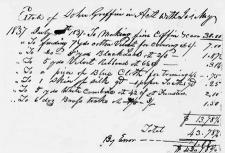You are here
Funeral Homes
The Funeral Business
The funeral business has been an evolution from that of small scale and necessity to big business and corporations. Early coffin makers were usually local carpenters that made furniture as their primary source of income.
A simple box with a lid, made from area wood, was the primary type of coffin. Later, more decorative styles were added. Fabric liners, ribbon and covered buttons could be used to decorate the coffin for an extra fee. Receipts for funerals as well as a description of the items purchased may be a part of the administration of a will found in courthouse records.
As the population grew and styles changed, the process of a funeral could last for days and involve just one company. Visitations that once occurred in homes were moved to elaborately appointed funeral homes. Funeral homes would sell the casket, vault, funeral preparations, flowers, acknowledgement stationery, monument, and hearst and family cars.
This photo shows a Cadillac driven by Don Wilson and owned by Douglas and Sing. This vehicle had a detachable hood that could be replaced to make it an ambulance. It normally stayed as an ambulance unless it was needed for a funeral.
Even though segregation laws have long since been changed, the funeral business in Mecklenburg County is historically and currently mostly segregated by personal choice.
Mecklenburg County Funeral Homes: Undertakers and Embalmers, 1879-1945
The funeral homes and undertakers listed here are found in various Charlotte city directories. The date given is the first time the name appears in a directory. City directories are usually distributed at the beginning of each year and have information from the previous year. There may have been other funeral homes and undertakers that served the county and are not included in this list. The race was designated in early city directories.
Mecklenburg County has been a place of many mergers and break ups in the funeral home industry. Although many funeral homes still have family names in this county, most have been bought by large corporations and retain their former name for community recognition.
The Hovis Mortuary, once located in Charlotte at 508 N. Tryon, was designed by architect William Peeps and was featured in his book published in 1928.
Funeral Homes and Suppliers - August, 2001 - follow this link for a table showing 28 different businesses.










